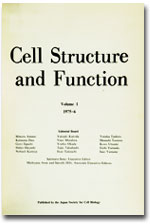Volume 21, Issue 5
Displaying 1-23 of 23 articles from this issue
- |<
- <
- 1
- >
- >|
-
1996 Volume 21 Issue 5 Pages 277-282
Published: 1996
Released on J-STAGE: March 27, 2006
Download PDF (4070K) -
1996 Volume 21 Issue 5 Pages 283-295
Published: 1996
Released on J-STAGE: March 27, 2006
Download PDF (6644K) -
1996 Volume 21 Issue 5 Pages 297-306
Published: 1996
Released on J-STAGE: March 27, 2006
Download PDF (9254K) -
1996 Volume 21 Issue 5 Pages 307-315
Published: 1996
Released on J-STAGE: March 27, 2006
Download PDF (1802K) -
1996 Volume 21 Issue 5 Pages 317-326
Published: 1996
Released on J-STAGE: March 27, 2006
Download PDF (6824K) -
1996 Volume 21 Issue 5 Pages 329-330
Published: 1996
Released on J-STAGE: April 19, 2006
Download PDF (180K) -
1996 Volume 21 Issue 5 Pages 331-342
Published: 1996
Released on J-STAGE: March 27, 2006
Download PDF (6261K) -
1996 Volume 21 Issue 5 Pages 343-349
Published: 1996
Released on J-STAGE: March 27, 2006
Download PDF (1854K) -
1996 Volume 21 Issue 5 Pages 351-356
Published: 1996
Released on J-STAGE: March 27, 2006
Download PDF (1058K) -
1996 Volume 21 Issue 5 Pages 357-367
Published: 1996
Released on J-STAGE: March 27, 2006
Download PDF (6585K) -
1996 Volume 21 Issue 5 Pages 369-373
Published: 1996
Released on J-STAGE: March 27, 2006
Download PDF (895K) -
1996 Volume 21 Issue 5 Pages 375-379
Published: 1996
Released on J-STAGE: March 27, 2006
Download PDF (797K) -
1996 Volume 21 Issue 5 Pages 381-385
Published: 1996
Released on J-STAGE: March 27, 2006
Download PDF (2431K) -
1996 Volume 21 Issue 5 Pages 387-393
Published: 1996
Released on J-STAGE: April 19, 2006
Download PDF (1447K) -
1996 Volume 21 Issue 5 Pages 395-402
Published: 1996
Released on J-STAGE: April 19, 2006
Download PDF (2761K) -
1996 Volume 21 Issue 5 Pages 403-406
Published: 1996
Released on J-STAGE: March 27, 2006
Download PDF (757K) -
1996 Volume 21 Issue 5 Pages 407-412
Published: 1996
Released on J-STAGE: March 27, 2006
Download PDF (1210K) -
1996 Volume 21 Issue 5 Pages 413-419
Published: 1996
Released on J-STAGE: March 27, 2006
Download PDF (1505K) -
1996 Volume 21 Issue 5 Pages 421-424
Published: 1996
Released on J-STAGE: March 27, 2006
Download PDF (790K) -
1996 Volume 21 Issue 5 Pages 425-430
Published: 1996
Released on J-STAGE: March 27, 2006
Download PDF (1822K) -
1996 Volume 21 Issue 5 Pages 431-436
Published: 1996
Released on J-STAGE: March 27, 2006
Download PDF (1124K) -
1996 Volume 21 Issue 5 Pages 437-444
Published: 1996
Released on J-STAGE: March 27, 2006
Download PDF (1445K) -
1996 Volume 21 Issue 5 Pages 445-450
Published: 1996
Released on J-STAGE: March 27, 2006
Download PDF (1186K)
- |<
- <
- 1
- >
- >|
